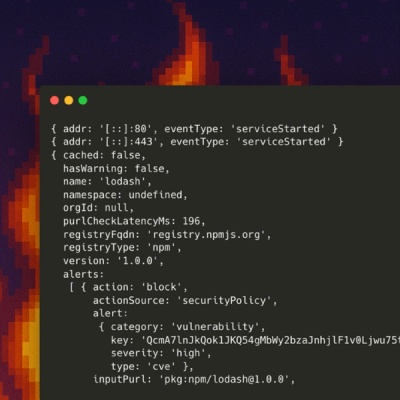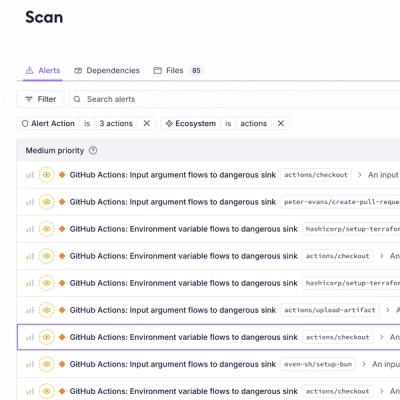
Product
Introducing Socket Firewall Enterprise: Flexible, Configurable Protection for Modern Package Ecosystems
Socket Firewall Enterprise is now available with flexible deployment, configurable policies, and expanded language support.
non-layered-tidy-tree-layout
Advanced tools
Draw non-layered tidy trees in linear time.
This a JavaScript port from the project cwi-swat/non-layered-tidy-trees, which is written in Java. The algorithm used in that project is from the paper by A.J. van der Ploeg, Drawing Non-layered Tidy Trees in Linear Time. There is another JavaScript port from that project d3-flextree, which depends on d3-hierarchy. This project is dependency free.
npm install non-layered-tidy-tree-layout
Or
yarn add non-layered-tidy-tree-layout
There's also a built verison: dist/non-layered-tidy-tree-layout.js for use with browser <script> tag, or as a Javascript module.
import { BoundingBox, Layout } from 'non-layered-tidy-tree-layout'
// BoundingBox(gap, bottomPadding)
const bb = new BoundingBox(10, 20)
const layout = new Layout(bb)
const treeData = {
id: 0,
width: 40,
height: 40,
children: [
{
id: 1,
width: 40,
height: 40,
children: [{ id: 6, width: 400, height: 40 }]
},
{ id: 2, width: 40, height: 40 },
{ id: 3, width: 40, height: 40 },
{ id: 4, width: 40, height: 40 },
{ id: 5, width: 40, height: 80 }
]
}
const { result, boundingBox } = layout.layout(treeData)
// result:
// {
// id: 0,
// x: 300,
// y: 0,
// width: 40,
// height: 40,
// children: [
// {
// id: 1,
// x: 185,
// y: 60,
// width: 40,
// height: 40,
// children: [
// { id: 6, x: 5, y: 120, width: 400, height: 40 }
// ]
// },
// { id: 2, x: 242.5, y: 60, width: 40, height: 40 },
// { id: 3, x: 300, y: 60, width: 40, height: 40 },
// { id: 4, x: 357.5, y: 60, width: 40, height: 40 },
// { id: 5, x: 415, y: 60, width: 40, height: 80 }
// ]
// }
//
// boundingBox:
// {
// left: 5,
// right: 455,
// top: 0,
// bottom: 160
// }
The method Layout.layout modifies treeData inplace. It returns an object like { result: treeData, boundingBox: {left: num, right: num, top: num, bottom: num} }. result is the same object treeData with calculated coordinates, boundingBox are the coordinates for the whole tree:

The red dashed lines are the bounding boxes for each node. Layout.layout() produces coordinates to draw nodes, which are the grey boxes with black border.
The library also provides a class Tree and a method layout.
/**
* Constructor for Tree.
* @param {number} width - width of bounding box
* @param {number} height - height of bounding box
* @param {number} y - veritcal coordinate of bounding box
* @param {array} children - a list of Tree instances
*/
new Tree(width, height, y, children)
/**
* Calculate x, y coordindates and assign them to tree.
* @param {Object} tree - a Tree object
*/
layout(tree)
In case your data structure are not the same as provided by the example above, you can refer to src/helpers.js to implement a Layout class that converts your data to a Tree, then call layout to calculate the coordinates for drawing.
Layout.getSize and Layout.assignLayout and Layout.layoutLayout.layoutLayout.layoutTreeDataLayout, BoundingBox, layout, TreeFAQs
Draw non-layered tidy trees in linear time
The npm package non-layered-tidy-tree-layout receives a total of 385,122 weekly downloads. As such, non-layered-tidy-tree-layout popularity was classified as popular.
We found that non-layered-tidy-tree-layout demonstrated a not healthy version release cadence and project activity because the last version was released a year ago. It has 1 open source maintainer collaborating on the project.
Did you know?

Socket for GitHub automatically highlights issues in each pull request and monitors the health of all your open source dependencies. Discover the contents of your packages and block harmful activity before you install or update your dependencies.

Product
Socket Firewall Enterprise is now available with flexible deployment, configurable policies, and expanded language support.

Security News
Open source dashboard CNAPulse tracks CVE Numbering Authorities’ publishing activity, highlighting trends and transparency across the CVE ecosystem.

Product
Detect malware, unsafe data flows, and license issues in GitHub Actions with Socket’s new workflow scanning support.